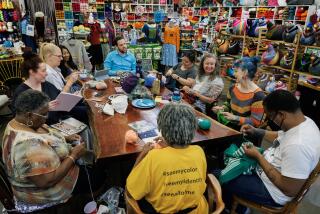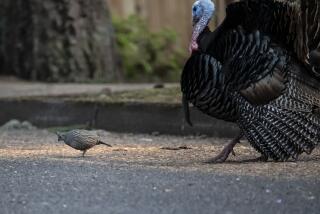BOOK REVIEW : One Family That’s a Flock of Fun : TO THE BIRDHOUSE<i> by Cathleen Schine</i> Farrar, Straus & Giroux $16.95, 273 pages
- Share via
As “To the Birdhouse” opens, Alice Brody is a happy woman. She has just married Peter Eiger, a rare bird of solitary habits who makes his living doing baseball statistics. Alice’s brother, young Willie, is still in his bachelor stage, about midway through a string of ethnically variegated girlfriends, the current one a Japanese sociologist named Yuki. Alice’s father has flown from the family nest and married again, but the rest of the relatives--Alice’s relentlessly eccentric grandma and an assortment of aunts and great-aunts--make up a friendly, nurturing flock.
Only Brenda, Alice’s mother, seems unhappy. A kind and beautiful dove, she has somehow gotten mixed up with Louie Scifo, a kind of immigrant Italian carrion crow. Louie deals in stolen goods and secondhand furniture. He wears gabardine leisure suits and butts in where he’s not wanted. He’s an embarrassment, a disaster, and although Alice--as a newly married woman--wishes domestic contentment on everyone she knows, she draws the line at Louie. He’s a curse.
Brenda soon finds this out for herself. She breaks up with Louie, but he will have none of it. His heart (if he has a heart) is broken. In a string of bizarre incidents, Louie begins the secondary courtship of the already rejected lover: He bashes in Brenda’s windows, puts black widow spiders under her pillow, makes crank phone calls to her and her extended family at all hours of the day and night. Finally, he hauls out his binoculars and begins watching the Brody family. Alice can’t look out of a window into a tree without seeing a ClamberingLouie, his binoculars trained on her.
For Alice, this is particularly disconcerting. She is a bird watcher by trade, putting out a newsletter for New York Birders. The morning after her wedding night, she rises early to take the subway to Prospect Park, all for the sake of a Bullock’s Oriole, blown in from the Rockies on the mighty wings of a winter storm.
The story of Alice’s first year of married life, then, is punctuated by typed lists of birds she spots: On Sept. 15, at the Jamaica Bay Wildlife Refuge: “1. 2 Pied-Billed Grebes, 2. 14 double-crested cormorants, 3. 2 great blue herons,” and so on. When Alice is happy, she sees a lot (this particular list runs to 53 items). When she’s sad, or tormented by Louie, she finds only: “1. 67 Cicada shells.”
By now, the family has moved to Brenda’s summer home in Westport, Conn. Louie has gotten himself hired as a gardener by the woman next door and runs a power mower back and forth across their yard, howling, “Brenda! Brenda!” Things have gotten out of hand, and Alice must devise a strategy to drive the Clambering Louie out of their collective lives.
Obviously, this book is not for everyone. You have to buy into the idea that all of us are terminally weird and driven by behavior patterns that are best described as birdbrained. Ethically, I must disclose my own bias here: This review was written on a day when seven California Jays, two pairs of nesting doves, one pair of nesting quail, eight house finches, one towhee and one red-shafted flicker flew through our patio. (But no Clambering Louies, thank God.)
Next: Lee Dembart reviews “When Technology Wounds: The Human Consequences of Progress” by Chellis Glendinning.
More to Read
Sign up for our Book Club newsletter
Get the latest news, events and more from the Los Angeles Times Book Club, and help us get L.A. reading and talking.
You may occasionally receive promotional content from the Los Angeles Times.










